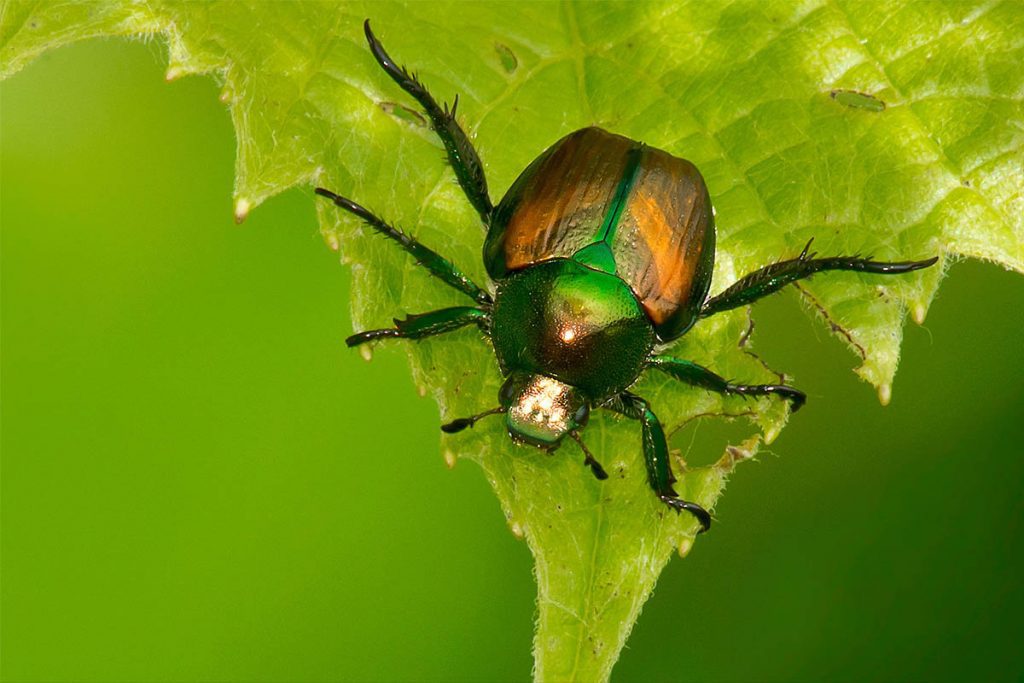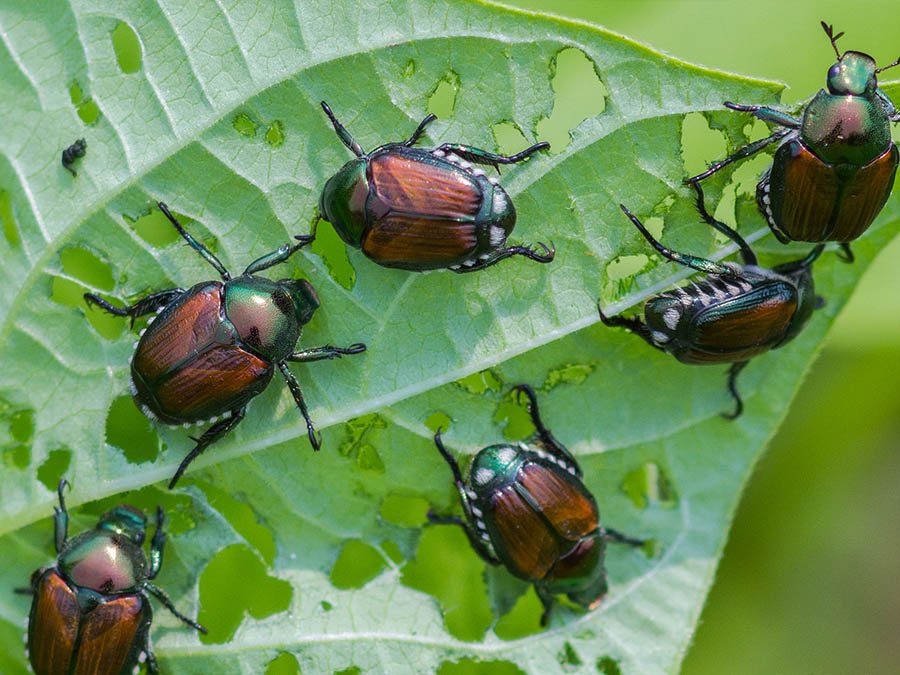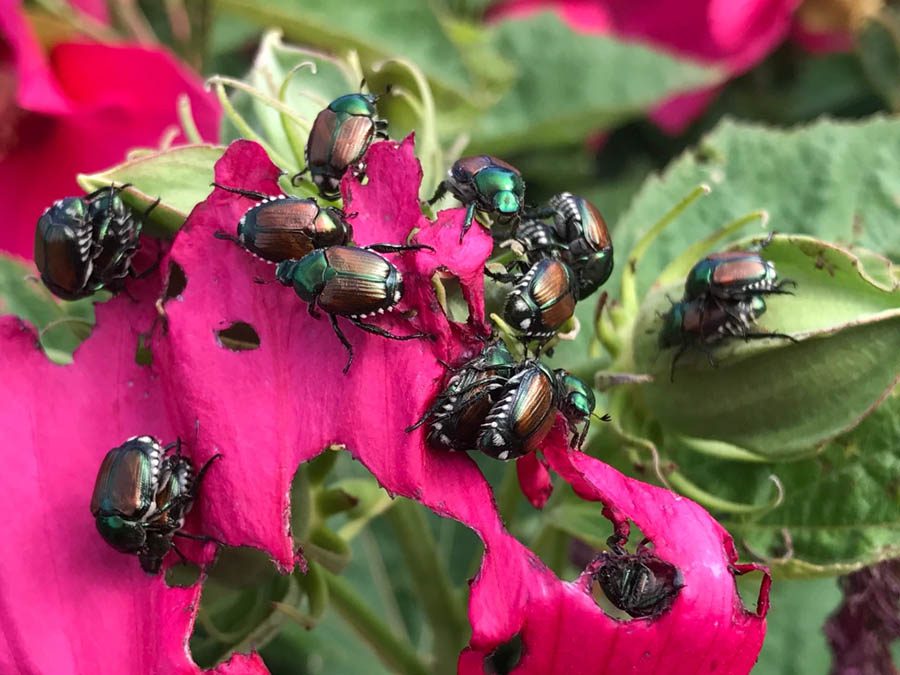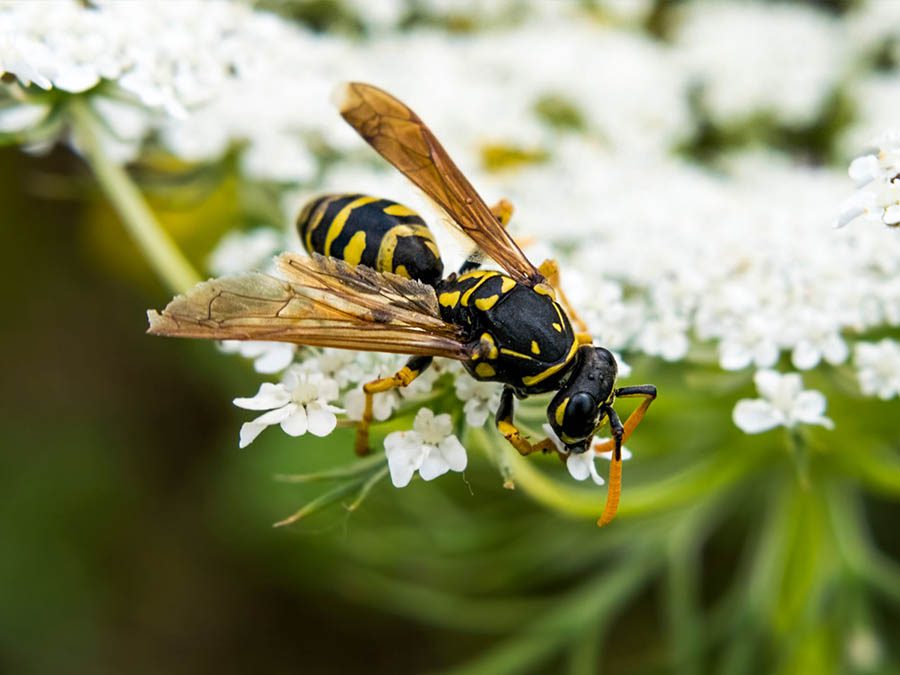The Japanese beetle is one of the most common insects in the world. It feeds mainly on the roots, leaves of plants. They are very dangerous because they can cause damage to plants, crops, and even buildings. If you find them in your garden or your yard, we have some solutions that will help you get rid of them. In this blog, I will show you how to get rid of Japanese Beetles with simple solutions.

Learn more: How To Get Rid of Aphids
What are Japanese Beetles?
Japanese beetles are a garden and lawn pest that were unintentionally introduced to the United States in 1916 via contaminated imported plants. They can cause substantial harm to gardens and lawns and grow to be about half an inch long.
Japanese beetles (scientific name Popillia japonica) are a green-bodied beetle with copper colored wing covers that can grow up to one inch long. They have white spots on their wings and legs, which help them camouflage in the bark of trees.
Japanese beetles feed on the leaves of many different types of plants, including roses, soybeans and corn. When a female beetle lays eggs in plant tissue it will disrupt how that plant grows and can even kill it.
Japanese beetles are most active in the months of June, July and August. They are attracted to the color yellow, so they will often be found around flowers and other plants that have yellow petals or leaves.
The Japanese beetle can lay up to 60 eggs during the course of its two-month lifespan as an adult. After two weeks, the eggs hatch and the white grubs begin feeding on dirt and grass roots while developing. Summer is the time of year when these young adult Japanese beetles emerge from the ground and fly for miles in search of food.
How to Identify a Japanese Beetle Infestation
Japanese beetles are a major pest of many plants, and can cause significant damage. They can be identified by their characteristic metallic green color and by the presence of five spots on their back.
Japanese beetles can be identified by their oval shape, copper-colored outer wing shell, and six to eight clusters of white hair around the abdomen that usually have a metallic sheen.

Adult Japanese beetles feed on plants outdoors in open areas without fear.
Grubs that will feed off the roots of plants before becoming adults are also an indication of a Japanese beetle infestation.
Japanese beetle larvae feed on the sap of hardwood trees, including oak, maple, and walnut.
Japanese beetles lay their eggs in clusters on the bark or under the leaves of infested trees.
The eggs hatch into small white grubs that feed on tree sap until they reach adulthood and produce more eggs.
Adult Japanese beetles can damage tree foliage and twigs as they feed, causing them to turn yellow or brown and dieback at the tips due to lack of water and nutrients uptake
To identify an infestation, look for signs such as damaged trees or shrubs with dead foliage near homes or businesses; large numbers of flying beetles; buggy egg masses found around infected trees; sweet smelling Secretions from adult beetles
Life Cycle of the Japanese Beetle
The Japanese beetle has a life cycle that consists of four stages: egg, larva, pupa, and adult.
Adult beetles overwinter in the soil, and females lay eggs about two weeks after becoming adults.
The eggs hatch into larvae, which feed on organic matter and grass roots until late fall when they overwinter again to emerge as adults the following spring.
Adults are metallic blue-green with copper backs and can be identified by their 1/2 inch size.
They often attack plants in groups, so damage is severe. Adults live for only 40 days but can consume many plants during their short lifespan.
In addition, they can travel up to 100 miles from where they were born meaning that even if you control your population now, you might not be able to stop them from spreading over time.
Damage Caused by the Japanese Beetle
Japanese Beetle damage can be identified by the appearance of their skeletonized leaves. If you see brown patches of dead or dying grass in your lawn, this may be an indication that you have a Japanese Beetle problem.

Additionally, the roots of plants can easily break when infested with Japanese Beetles, which will pull up the turf and leave bare patches in your lawn.
Japanese beetle damage can be identified by the appearance of their skeletonized leaves–leaves with only the veins remaining.
The Japanese beetle can cause brown patches of dead or dying grass to form in the lawn. If enough roots are killed, the turf will pull up easily–a telltale sign of beetle infestation.
The Japanese beetle also damages crops and forests, making it a significant pest to many industries and homeowners alike
The Japanese Beetle is a pest that can cause extensive damage to plants. This beetle feeds on the leaves of plants, leaving behind a lace-like skeleton. The Japanese Beetle typically travels no more than 100 feet from where it first damages leaves.
The Japanese beetle also damages crops and forests. In fact, this beetle is so destructive that it has been known to fly as far as 5 miles from where it began feeding! Because they are so difficult to control or prevent, using pesticides or traps in the ground is often necessary to get rid of them.
How to Get Rid of Japanese Beetles Garden and Yard
Hand Pick Them Off Your Plants
The best way to get rid of Japanese beetles is by hand picking them off the plants. Adults are found most often during the early morning or late afternoon, so it’s easiest to pick them off at night when they are sluggish.
Pick off the beetles one by one and immediately drop them into a pail of soapy water to avoid getting bitten. Make pet chickens or huge fish happy with insects you’ve hand-picked!
Neem Oil

Neem oil is a naturally occurring pesticide that has been used for decades to get rid of Japanese Beetles. It interferes with hormone production in insects, and the adults pass it on to their eggs. This can be passed down from infestation to infestation, resulting in a long term solution that doesn’t harm your plants. Neem oil is also a powerful insect repellent – Japanese beetles will move to other plants in the yard if they are not covered with neem oil, so you’ll have to spray them regularly for long-term results.
Bring on the Guinea Fowl
Guinea fowl make great garden helpers! Not only do they eat any bug in existence, but they will not tear up your garden and they will eat anything that bugs it- from slugs to Japanese beetles.
If you can’t have guinea fowl, find a way to attract birds. Putting out bird feeders and baths will bring in the feathered friends who will take care of your beetle problem for you. Another option is to buy an electric fence which will help keep the beetle population in control.
The process of spraying the yard with soapy water will attract birds which are hungry for Japanese beetle larvae. This should be done in fall and late spring when Japanese beetles are in their larval stage.
Cover Your Rows
Japanese beetles are only active for 6-8 weeks a year, so it is important to cover your rows during that time. Floating row covers can be effective in trapping Japanese beetle grubs, but it is not effective if the plants have already been infested by the beetles.
Don’t Use Beetle Traps
Traps are not recommended because they attract the beetles which can make a problem worse. Japanese beetle traps use pheromones to attract the beetles, so be careful where you place them on your property if you want to avoid attracting more bugs. The Japanese beetle traps are better at attracting beetles than trapping them.
So, unless you want to deal with an influx of these pests, it is best to avoid using traps altogether. Traps should be used around the perimeter of a property to protect plants from being attacked by beetles; if your property is large, set up traps in different locations for best results.
Geraniums
The Japanese Beetle was introduced to the United States in 1892.
The natural way to get rid of Japanese Beetles is to plant geraniums around their colonies and near plants you don’t want them to eat.
Japanese beetles are repelled by the smell of geranium oil.
Japanese beetle infestation can be controlled by spraying with a mix of 12 drops of geranium oil in one cup of water, but it is best to only use this method as a last resort.
Garlic
Garlic is a great way to repel Japanese beetles. It’s a natural repellent that doesn’t use any harsh chemicals. You can plant it near your plants, and the garlic will help keep the beetles away.

Beneficial Nematodes
Beneficial nematodes are microscopic worms that kill pests while allowing a natural hunter-prey relationship to play out. The nematodes release bacteria into the pest’s bloodstream, which eventually kills the grubs. Beneficial nematodes are easy to use and can be applied after a deluge. Nematodes need moisture to survive, so make sure you water the soil before releasing them. Japanese beetles like as many six hours of water per week and can be killed with organic products. Irrigation every seven days is a good idea for dry areas in order to kill Japanese beetles
Don’t Water Your Lawn
It might seem counterintuitive, but watering your lawn actually does more harm than good. In fact, overwatering can lead to a number of problems, such as:
-The grass will become waterlogged and drown
-Weeds will take over because they’re better adapted to wet conditions
-The soil will become compacted, which makes it difficult for the grass to get the nutrients it needs
Learn more:
How to get rid of Crabgrass
How to Get Rid of Clover
How to get rid of Dandelions
Natural Predators of Japanese Beetles
There are many animals that help to keep the Japanese beetle population under control. These predators eat the beetles or destroy their eggs, larvae, and pupae. Some of these predators include spiders, raccoons, moles, toads, various types of birds (fowls and songbirds), wasps, and ground beetles.
There are a few natural predators of Japanese beetles, although they can occasionally cause more damage to grass and plants than the beetles and grubs. This is due to the fact that they have to dig and scratch around to discover them!

How to Prevent Japanese Beetles
One of the best ways to prevent an infestation of Japanese beetles is to get rid of grubs that turn into adult beetles. You can do this by making sure your lawn doesn’t get too wet during the summer months, as this will help to eradicate eggs. Additionally, you can cover plants with a row cover which will keep the beetles from laying eggs on them in the first place.
Another method for preventing beetle eggs from hatching is to treat grubs in your lawn. This can be done in late summer through fall and again in spring for long-term control. There are different strains of nematodes that seek out pests living in soil, killing them upon contact. Nematodes are best used against Japanese beetle grubs and they offer long-term protection against these pests returning.
While waiting for nematodes or milky spore powder (a natural bacteria) to take effect, you can also use another method such as spray the lawn with a solution made up of 2T liquid dish soap diluted in 1 gallon of water per 1000 square feet.
Birds are natural predators of grubs and can be lured to the surface by spraying them with a mixture similar to what’s been mentioned above–2 T liquid dish soap diluted in 1 gallon of water per 1000 square feet.
Frequently Asked Questions
Will peppermint oil keep Japanese beetles away?
Insects can be a huge nuisance in orchards, as they can damage the fruit. Luckily, plant-based neem oils can be used to kill them off before they cause too much harm.
Neem oils are extracted from the leaves and fruits of plants, including neem, citronella and jasmine. These oils work by blocking the insect’s ability to eat.
It is non-toxic to both humans and animals, and it is a good choice for people who are looking for an organic option.
Neem oil is a yellowish-brown color with a slightly bitter taste, and it is completely organic.
Neem oil is a pesticide that can be sprayed on plants to help kill off the adult Japanese beetles. The chemical inside neem oil will help stop them from breeding and laying eggs, which will help reduce their population.
Will soapy water spray kill Japanese beetles?
Yes, a soapy water spray can kill Japanese beetles. The solution is made by mixing dish soap with water in a spray bottle, and then spraying it directly on the pests.
The soapy water will cause the beetles to drop from plants, leading to a higher likelihood of being eaten by animals like birds or other insects.
Yes, dish soap can kill Japanese beetles. In fact, any brand of dish soap should work. All you have to do is spray it directly on the beetles and they will die.
What essential oil attracts Japanese beetles?
Neem oil is a great, safe treatment for Japanese Beetles. It’s effective at killing them and doesn’t harm any beneficial insects. However, it’s harmful to aquatic life if it’s sprayed near bodies of water, so it’s best not to use this on your lawn if you live nearby.
Japanese beetles can be kept away with a variety of plants and smells. For example, if you plant lavender near your garden, the smell will deter the beetles. Additionally, essential oils such as cedar oil or peppermint oil can also be used to keep them at bay.
Will hydrogen peroxide kill Japanese beetles?
There is no easy answer when it comes to whether or not hydrogen peroxide will kill Japanese beetles. Pyrethrins are a common and highly effective pesticide against Japanese beetles, but they can be harmful to pollinators.
Pesticides are a quick and efficient way to kill Japanese beetles, but should only be used as a last resort.
The use of pesticides is not a recommended way to control Japanese beetles. Not only does it harm pollinating insects like bees, but it is also ineffective in the long term as the pests will eventually become resistant. Keeping flowers clean with pyrethrin-based sprays is a better option.
How do you make Japanese beetle attractant?
To make Japanese beetle attractant, mix 1 quart of water, 1 cup of molasses and 1 tablespoon of yeast. Place the mixture in a plastic bottle or jar with holes punched in the lid. The scent will attract Japanese beetles.
The mixture will ferment, so keep it in a warm place. Replace the liquid every few days and add more molasses to keep attracting beetles.
Does vinegar get rid of Japanese beetles?
The answer is yes, vinegar is a natural way to get rid of Japanese beetles. Spray it all over the area where they are and leave for about 15 minutes or so before wiping off with a damp cloth. Vinegar will kill them on contact.
Should pesticides be used to get rid of Japanese Beetles?
There are several methods for killing Japanese beetles, but the most common is to use a pesticide. Pesticides should always be a last resort, as they can have harmful effects on both people and the environment.
According to the University of Missouri Integrated Pet Management program:
Application of insecticides to control pests including Japanese beetles should be considered the last resort.
“When exploring chemical control options, farmers/gardeners should select the lowest risk and the most effective products.”
Japanese beetles can be controlled with low-risk, non-toxic pesticides such as horticultural oils or insecticidal soaps. These products will kill Japanese beetles and other pests for up to two weeks after application, but their effects are usually limited to the first two days of spraying them on plants.
You can also use residual pesticides, systemic insecticides, or both to control Japanese beetles. Residual pesticides last two to four weeks and systemic insecticides drench the soil so that plants soak in the chemicals through their roots. Systemic insecticides are chemical pesticides which target the whole plant and often affect any insects that feed on it. However, they are not recommended, as they may harm beneficial insects.









